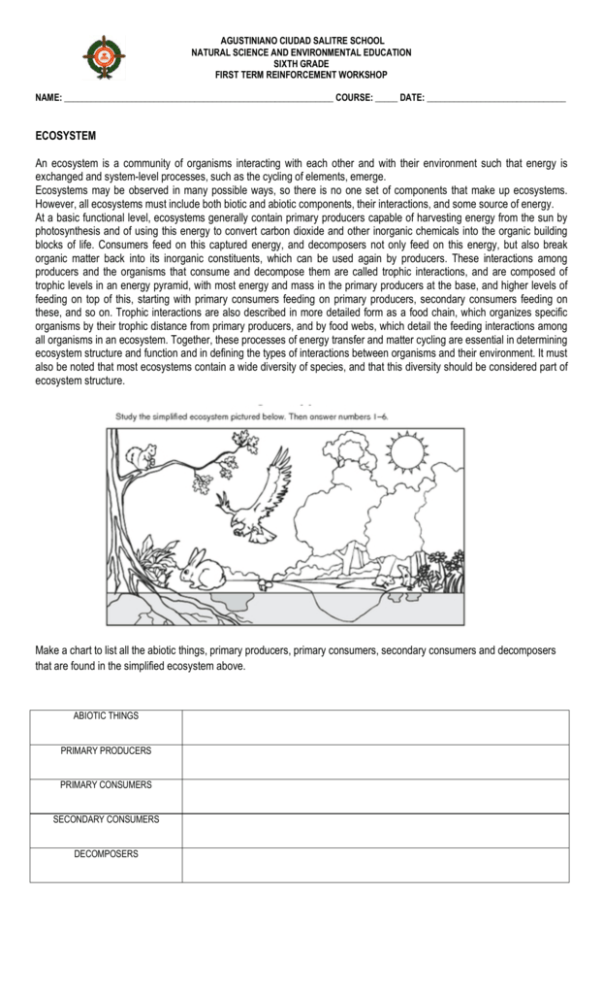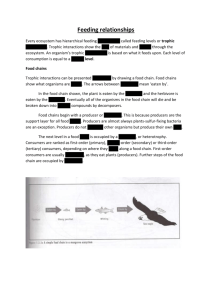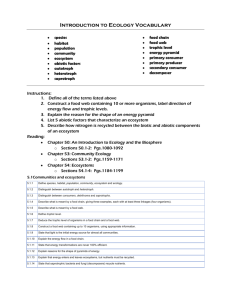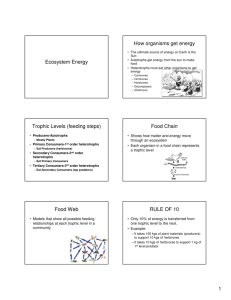ECOSYSTEM An ecosystem is a community of organisms interacting
advertisement

AGUSTINIANO CIUDAD SALITRE SCHOOL NATURAL SCIENCE AND ENVIRONMENTAL EDUCATION SIXTH GRADE FIRST TERM REINFORCEMENT WORKSHOP NAME: ____________________________________________________________ COURSE: _____ DATE: _______________________________ ECOSYSTEM An ecosystem is a community of organisms interacting with each other and with their environment such that energy is exchanged and system-level processes, such as the cycling of elements, emerge. Ecosystems may be observed in many possible ways, so there is no one set of components that make up ecosystems. However, all ecosystems must include both biotic and abiotic components, their interactions, and some source of energy. At a basic functional level, ecosystems generally contain primary producers capable of harvesting energy from the sun by photosynthesis and of using this energy to convert carbon dioxide and other inorganic chemicals into the organic building blocks of life. Consumers feed on this captured energy, and decomposers not only feed on this energy, but also break organic matter back into its inorganic constituents, which can be used again by producers. These interactions among producers and the organisms that consume and decompose them are called trophic interactions, and are composed of trophic levels in an energy pyramid, with most energy and mass in the primary producers at the base, and higher levels of feeding on top of this, starting with primary consumers feeding on primary producers, secondary consumers feeding on these, and so on. Trophic interactions are also described in more detailed form as a food chain, which organizes specific organisms by their trophic distance from primary producers, and by food webs, which detail the feeding interactions among all organisms in an ecosystem. Together, these processes of energy transfer and matter cycling are essential in determining ecosystem structure and function and in defining the types of interactions between organisms and their environment. It must also be noted that most ecosystems contain a wide diversity of species, and that this diversity should be considered part of ecosystem structure. Make a chart to list all the abiotic things, primary producers, primary consumers, secondary consumers and decomposers that are found in the simplified ecosystem above. ABIOTIC THINGS PRIMARY PRODUCERS PRIMARY CONSUMERS SECONDARY CONSUMERS DECOMPOSERS Remember that the biotic factors in an ecosystem could be organized in domains and kingdoms. Complete the concept map about them. Use the names, the cell types, cell numbers and which are their names based on how they can obtain the energy: TROPHIC LEVELS Trophic levels are the feeding position in a food chain such as primary producers, herbivore, primary carnivore, etc. Green plants form the first trophic level, the producers. Herbivores form the second trophic level, while carnivores form the third and even the fourth trophic levels. Summarizing write the name of the trophic levels: 1. ____________________________________ ___________________________________ 2. ____________________________________ ___________________________________ ___________________________________ ___________________________________ 3. ___________________________________ FOOD CHAINS The feeding of one organism upon another in a sequence of food transfers is known as a food chain. Another definition is the chain of transfer of energy (which typically comes from the sun) from one organism to another. Look at the example and next to it create your own: FOOD WEBS In an ecosystem there are many different food chains and many of these are cross-linked to form a food web. Ultimately all plants and animals in an ecosystem are part of this complex food web. AQUATIC FOOD WEB TERRESTRIAL FOOD WEB








